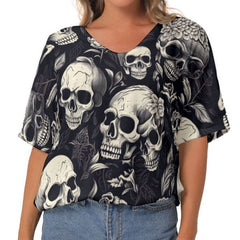
In the vast landscape of fashion, there exists a subculture that finds allure in the dark, the mysterious, and the macabre. Among its many expressions, one particularly striking trend is the donning of skull and gothic themed clothing. From skull-printed t-shirts to intricately designed gothic attire, these garments serve as a canvas for self-expression, reflecting a deeper aspect of human psychology and cultural fascination.
But why do people gravitate towards these dark motifs? What draws them to embrace the symbolism of mortality and darkness in their attire? Let’s delve into the intriguing world of skull and gothic fashion to uncover the underlying reasons behind its popularity.
Embracing Individuality and Nonconformity
At its core, fashion is a form of self-expression—a means to communicate one’s identity, beliefs, and emotions. For many, skull and gothic themed clothing serves as a rebellious statement against societal norms and conventional beauty standards. By adorning themselves in attire adorned with skulls, skeletons, and other dark motifs, individuals assert their autonomy and defiance against the mainstream.
In a world where conformity often reigns supreme, embracing gothic fashion is a bold assertion of individuality. It’s a way for people to carve out their own niche, to stand out from the crowd and proclaim their uniqueness. In essence, wearing skull and gothic themed clothing is a visual declaration of nonconformity—a refusal to be confined by societal expectations.
Exploring the Mysteries of Life and Death

The fascination with skull imagery is deeply rooted in humanity’s perpetual contemplation of life and death. Throughout history, skulls have served as potent symbols, representing mortality, transience, and the ephemeral nature of existence. By incorporating skulls into their clothing, individuals confront these existential themes head-on, embracing the beauty in life’s impermanence.
Gothic fashion, with its dark aesthetic and romanticized portrayal of death, offers a lens through which individuals can explore the mysteries of mortality. It’s a way to confront one’s own mortality, to grapple with the inevitability of death, and to find solace in the idea that even in darkness, there is beauty to be found.
Channeling Emotions and Inner Turmoil
Fashion has long been recognized as a form of emotional expression—a visual medium through which individuals can convey their innermost thoughts and feelings. For many, donning skull and gothic themed clothing serves as a cathartic release—an outward manifestation of inner turmoil, pain, or melancholy.
In a world fraught with complexities and uncertainties, gothic fashion provides an outlet for individuals to channel their emotions. The dark, brooding aesthetic of skull-themed attire resonates with those who may feel misunderstood or marginalized, offering a sense of belonging within a community that shares similar struggles and experiences.
Embracing the Aesthetics of Darkness

Beyond its psychological and emotional implications, there’s an undeniable allure to the aesthetics of darkness. Gothic fashion embodies a sense of drama, mystery, and romance—all of which contribute to its enduring appeal. From the intricate lacework of Victorian-inspired garments to the stark simplicity of skull motifs, there’s a beauty in the darkness that captivates the imagination.
For many aficionados of skull and gothic themed clothing, the allure lies in the juxtaposition of light and shadow, beauty and decay. It’s an aesthetic that celebrates the complexities of the human experience—the duality of life and death, light and darkness, beauty and decay.
Conclusion
In the realm of fashion, skull and gothic themed clothing stand out as a testament to the human fascination with darkness, mortality, and the unknown. Beyond mere garments, they serve as symbols of rebellion, introspection, and self-expression. Whether worn as a statement of individuality, a means of confronting existential truths, or simply as a celebration of the aesthetics of darkness, these garments hold a profound significance for those who embrace them.
In a world that often shies away from the darker aspects of life, skull and gothic fashion offer a sanctuary—a space where individuals can explore the depths of their psyche, confront their fears, and embrace the beauty in life’s imperfections. It is through these garments that we find not only a reflection of our own mortality but also a celebration of the rich tapestry of human experience.
